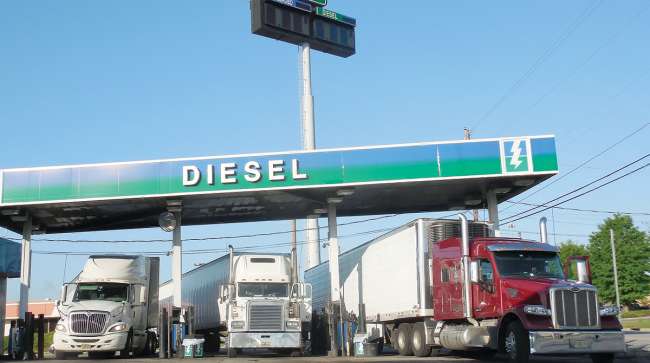Senior Reporter
Diesel Jumps 4¢ to $3.006 a Gallon

The U.S. average retail price of diesel rose 4 cents to $3.006 a gallon, according to the Department of Energy. Likewise, crude prices climbed into the mid-$50 range as international supplies tightened and concerns over a deeper trade war with China lessened.
The price of diesel broke a string of five weeks in which it had been below $3 a gallon.
The national diesel average price is 2.1 cents lower than it was a year ago, when the price was $2.985, DOE said after its Feb. 18 survey of fueling stations, reported the day after the U.S. Presidents Day holiday.
The regional average diesel prices rose in every area, with California notching the highest at $3.739 a gallon.
Additionally, the U.S. regular gasoline average price rose 4.1 cents to $2.317 a gallon, 24 cents lower than a year ago, DOE’s Energy Information Administration said.

Dana's Steve Slesinski. (John Sommers II for Transport Topics)
Meanwhile, a commercial vehicle supplier executive pointed to highly engineered axles as a means of increasing fuel efficiency.
The biggest benefit in improved axle design (including gears, bearings and assemblies) is to allow the engine to turn slower at highway cruise speeds, which results in less wear and more efficiency; and a robust driveshaft can provide higher torque through the drivetrain system, Steve Slesinski, director of product planning for Dana’s commercial vehicle business, told Transport Topics.
“A lot of the technology that we are applying now to commercial vehicle axles has been acquired and developed over a long period of time through our automotive business, which has been a big proponent of efficiency for quite some time,” he said.
Also, Dana has eliminated a lot of weight from its product line of driveshafts, and steer and drive axles to make them “enablers of additional efficiency for fleet customers,” he said.
There are some bulk haulers that are very sensitive about weight and “so every pound saved means additional revenue for them. Those guys are very familiar with the weight-saving benefit,” Slesinski said.
“The efficiency guys are probably another 30% to 40% of the market that actually go through and spec the components so that they provide the most efficient product,” he said.
“And then there are some truck operators who depend on either the price book or dealer salesperson to direct them into a solution,” he added.
At the same time, fuel-saving hybrid technology is available for linehaul applications where axles with motors on them can be used to generate energy and propel the vehicle in acceleration or climbing hills, he said.
The technology also regenerates electricity when a truck is going down hills or stopping, Slesinski said. “These systems show large promise to improve the efficiency of on-highway Class 8 vehicles.”
U.S. average #diesel fuel price on 2/18/19 was $3.006/gal, UP 4.0¢/gallon from 2/11/19, DOWN 2.1¢/gallon from year ago https://t.co/3LAVQ7LWAO #truckers #shippers #fuelprices pic.twitter.com/glKbQZImpk — EIA (@EIAgov) February 20, 2019
Dana provides large electric motors and inverters, too, that can replace a conventional engine and transmission and power a vehicle with full battery-electric propulsion with a known duty cycle and a typically shorter range.
But the pace of declines of battery prices has flattened out, David Ross, an analyst with Stifel, Nicolaus & Co., wrote in a recent note, “which makes us think the adoption curve for electric will be slower, since [the cost of batteries] is the biggest reason for the higher capital cost of an electric vehicle. The exception is locations where electric will be mandated.”
In the meantime, crude futures on the New York Mercantile Exchange closed Feb. 19 at $56.09 per barrel, a three-month high, compared with $52.41 on Feb. 11.
At the same time, the United States and China sent signals after recent talks in Beijing that the sides may be approaching a deal, raising hopes that the nations’ trade war will ease. Prices also were supported as Saudi Arabia pledges to cut its crude output beyond the level agreed with OPEC producers, Bloomberg News reported.
Declining production in Iran, Libya and Venezuela also is helping to tighten the market.
“Saudi Arabia seems willing to do whatever is necessary to reach levels of $80 a barrel, and judging by the price reaction, they’re on track,” Eugen Weinberg, head of commodities research at Commerzbank AG in Frankfurt, Germany, told Bloomberg. “Even rather bearish factors, like a stronger-than-expected rise in U.S. oil production, does not seem to derail the price recovery.”
The last time West Texas Intermediate crude was at $80 a barrel was Oct. 31, 2014, when it was $80.54.
On Nov. 3 of that year, the national average price of a gallon of diesel was $3.623.




